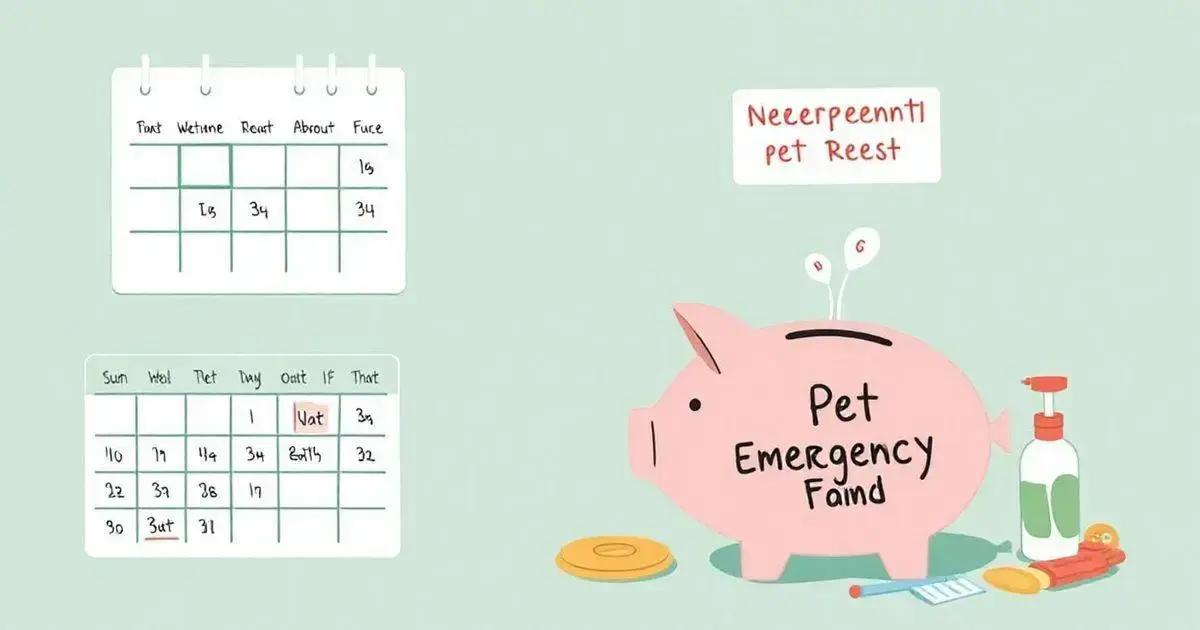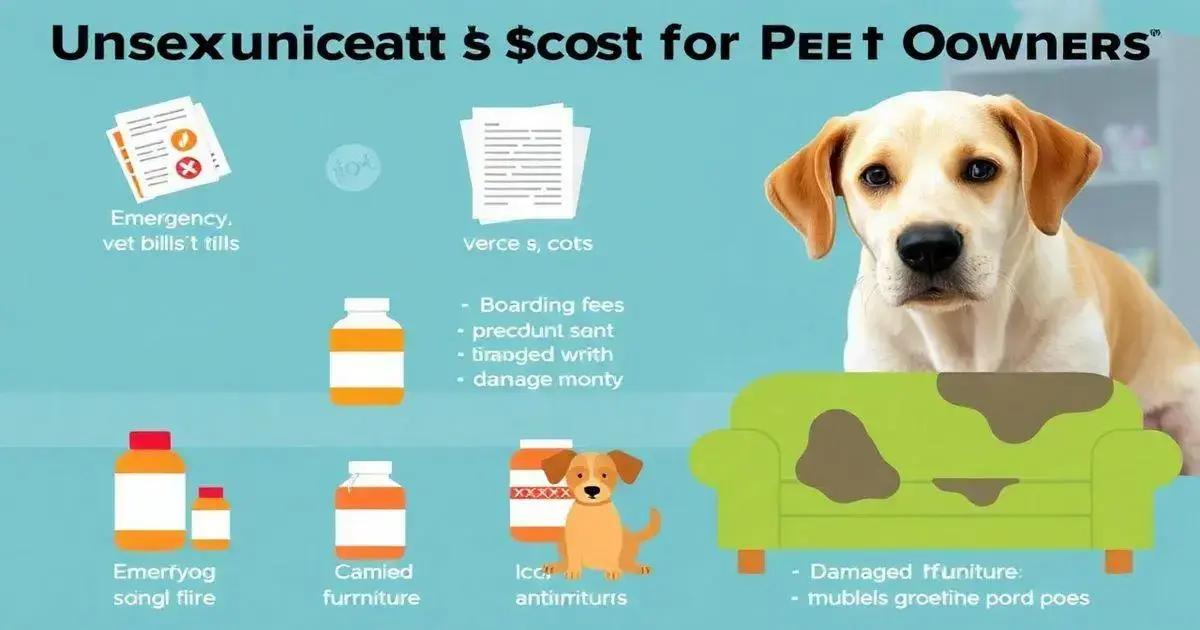Establishing a pet emergency fund is crucial for every responsible pet owner. It ensures that in times of crisis, you have the financial resources to take care of your furry family members.
Whether it’s an unexpected illness or an unfortunate accident, having a financial cushion can alleviate stress and allow you to focus on what’s most important: your pet’s health and happiness.
In this article, we’ll explore how to create a pet emergency fund, why it’s necessary, and practical tips for building it effectively.
What is a Pet Emergency Fund?
A pet emergency fund is a dedicated savings account specifically for your pet’s unexpected medical expenses. Just like humans, pets can experience illnesses, injuries, or accidents that lead to costly veterinary treatments. Having this financial safety net offers peace of mind for pet owners and ensures that you can provide immediate care when it’s needed the most.
Why Create a Pet Emergency Fund?
Pets rely on us for their well-being, and emergencies can happen at any time. A pet emergency fund empowers you to make swift decisions regarding your pet’s health without the added stress of financial uncertainty. It allows you to focus on getting your pet the care they need without delay.
Typical Expenses Covered by a Pet Emergency Fund
Common costs that may arise unexpectedly include:
- Emergency surgery due to accidents
- Hospitalization for serious illness
- Diagnostic tests for unexplained symptoms
- Prescription medications
- Specialist consultations
These expenses can add up quickly, making it crucial to be prepared with a financial buffer.
How It Differs From Regular Savings
While you may have general savings for various purposes, a pet emergency fund is specifically earmarked for your pet’s health needs. This helps prioritize your pet’s financial needs and ensures that funds are readily available when circumstances arise.
Why You Need a Pet Emergency Fund

Understanding why you need a pet emergency fund is crucial for every pet owner. Unexpected health issues and accidents can arise, and being financially ready is key. A pet emergency fund allows you to cover veterinary bills without stressing over your finances.
Peace of Mind
Having a designated fund gives you peace of mind. You won’t have to wonder where the money will come from if your furry friend faces a crisis. Instead, you can focus on providing the best possible care for your pet.
High Veterinary Costs
Veterinary treatments can be very expensive. For example, emergency surgeries and specialized treatments can cost hundreds to thousands of dollars. Without a pet emergency fund, you may have to choose between your pet’s needs and your financial stability.
Quick Access to Funds
When emergencies happen, time is of the essence. A pet emergency fund ensures quick access to funds when your pet requires immediate attention. This means less delay in treatment and a better chance for a positive outcome.
Avoiding Debt
Relying on credit cards or loans for unexpected pet expenses can lead to debt and financial stress. A well-funded emergency account helps you avoid accumulating high-interest debt just to cover your pet’s urgent medical needs.
Preventative Care
Having a pet emergency fund encourages regular check-ups and preventative care. Knowing you have savings can motivate you to keep up with vet visits, vaccinations, and dental care, reducing the likelihood of sudden issues arising later.
How Much Should You Save for Your Pet?
Determining how much you should save for your pet is an essential part of having a pet emergency fund. Financial experts suggest aiming to save between $500 and $2,000 in your pet emergency fund. This range helps ensure that you can handle various unexpected costs.
Factors to Consider
Several factors can influence the amount you may need to set aside:
- Type of Pet: Different pets have varying healthcare needs. For example, a dog may require more extensive care than a cat, depending on its breed and size.
- Age of Your Pet: Older pets are more prone to health issues. If your pet is senior, consider saving on the higher end of the range.
- Health History: If your pet has had health problems in the past, it’s wise to save more to cover future emergencies.
- Veterinary Costs in Your Area: Costs can vary based on location. Research local vet clinics to gauge the average costs for surgeries and treatments.
Breaking Down Your Savings Goal
To reach your savings target, consider starting with a monthly saving plan:
- If your goal is $1,000 and you have a year to save, set aside about $84 each month.
- For a goal of $500, you would save approximately $42 each month for a year.
This method allows you to build your fund gradually without feeling overwhelmed.
Re-evaluate Regularly
As your pet ages or if their health condition changes, make sure to re-evaluate how much you need in your emergency fund. Adjusting your savings plan accordingly can help keep you fully prepared for any situation.
Creating a Pet Emergency Fund Plan

Creating a pet emergency fund plan involves several steps to ensure that you are prepared for unexpected veterinary expenses. Here’s a straightforward guide to help you develop your plan.
1. Define Your Goal
Start by determining how much you want to save in your emergency fund. As mentioned earlier, a good target is between $500 and $2,000, depending on your pet’s needs and your financial situation.
2. Set a Monthly Contribution
Decide how much money you can comfortably set aside each month. This amount should align with your overall budgeting. For instance, if you plan to save $1,000 in one year, consider setting aside about $84 each month.
3. Choose a Savings Method
Select the best way for you to save your funds. Options include:
- High-Yield Savings Account: This is a safe option that earns interest over time.
- Separate Savings Account: You might want to open a dedicated account just for your pet’s emergency fund.
- Cash Envelope System: If you prefer cash, use an envelope to keep your savings organized.
4. Automate Your Savings
If possible, set up automatic transfers to your savings account each month. Automation can make saving easier and ensures you won’t forget it.
5. Monitor Your Progress
Regularly check your savings to see how you are doing. This will motivate you to keep going as you visualize reaching your goal.
6. Adjust as Needed
Life changes, and so may your pet’s needs. If you notice that your pet’s healthcare costs change or your financial situation alters, reevaluate your savings plan and adjust your contributions accordingly.
Where to Keep Your Pet Emergency Fund
Deciding where to keep your pet emergency fund is an important step in managing your finances. You want a place that is easily accessible but also safe. Here are several options to consider:
High-Yield Savings Account
A high-yield savings account is a great choice for your pet emergency fund. These accounts typically offer better interest rates than traditional savings accounts while keeping your funds safe. You can easily transfer money in and out when needed.
Separate Checking Account
Opening a separate checking account just for your pet fund can help keep your finances organized. This method ensures you will not accidentally spend your emergency funds on non-pet-related expenses.
Online Savings Accounts
Consider online banks, which often provide higher interest rates compared to brick-and-mortar institutions. Online banks are typically user-friendly, making it easy to manage your emergency fund from anywhere.
Cash Envelopes
If you prefer to keep cash, using cash envelopes labeled for your pet emergency fund is another option. This method allows you to have direct access to your funds, but be cautious about keeping large amounts of cash at home.
Money Market Accounts
Money market accounts can be a good alternative as they combine features of both savings and checking accounts. These accounts offer higher interest rates and allow you to write checks for emergencies.
Financial Apps
Consider using budgeting or financial apps that allow you to set up savings goals. Some apps can help you track your savings progress and manage your emergency fund conveniently from your phone.
Unexpected Costs for Pet Owners

Being a pet owner comes with many responsibilities, and unexpected costs for pet owners can arise at any moment. It’s crucial to be aware of these potential expenses to better prepare your pet emergency fund. Here are some common unexpected costs:
Emergency Veterinary Visits
One of the most significant unexpected costs can come from emergency vet visits. Accidents and sudden illnesses can occur, leading to urgent medical attention that may not be covered by regular vet visits.
Surgery and Specialist Care
If your pet requires surgery or needs to see a specialist, costs can escalate quickly. For instance, orthopedic surgeries or consultations with an animal behaviorist may require a considerable financial outlay.
Medication and Treatments
Pets may need medication long-term for chronic conditions or after surgery. The cost of prescription medications can add up over time, placing an additional strain on your budget.
Emergency Boarding
In certain situations, such as a family emergency or hospitalization, you may need emergency boarding for your pet. These last-minute arrangements can often come at a premium.
Routine Accidents
Pets can sometimes chew or damage household items, leading to repair costs. For example, if your pet chews on expensive furniture or carpets, you might need to replace them sooner than planned.
Training and Behavioral Issues
Unforeseen behavioral issues might arise that require professional training. Investing in training sessions can be essential for maintaining a harmonious household but can also add to your expenses.
Travel Expenses
If you decide to travel with your pet, unexpected travel expenses may occur. This can include additional fees for hotels that allow pets or extra costs for pet travel carriers.
Pet Food and Supplements
Some pets may develop dietary needs that require specialized food or supplements, which can be more expensive than standard pet food.
Tips for Building Your Fund
Building your pet emergency fund is an essential step for every pet owner. Here are some practical tips to help you grow your savings effectively:
Start Small
Begin with a manageable savings goal. You can start with just $10 to $20 a week. Small contributions can add up over time.
Set Up Automatic Transfers
Consider setting up automatic transfers from your checking account to your pet emergency fund account. This way, you will save without even thinking about it.
Cut Unnecessary Expenses
Review your monthly budget to identify areas where you can cut back. Redirect any savings from reduced expenses to your pet emergency fund.
Use Windfalls Wisely
If you receive any unexpected money, such as a tax refund or a bonus, consider putting a portion of it directly into your pet fund.
Create a Savings Challenge
Engage with family or friends in a savings challenge. Make it fun by setting specific goals and rewarding yourselves when you reach them. This helps maintain motivation.
Keep Your Fund Separate
By keeping your pet emergency fund in a separate account, you will reduce the temptation to use it for non-emergent expenses. This can help your savings grow more effectively.
Track Your Progress
Monitoring your savings progress can provide powerful motivation. Use a savings app or spreadsheet to see how far you’ve come and adjust your goals as needed.
Use Coupons and Discounts
Save money on regular pet expenses by using coupons or discounts. Redirect the money saved into your emergency fund.
Using an Emergency Fund Wisely

Using your emergency fund wisely is crucial for ensuring your pet’s well-being. When it comes time to access these funds, consider the following tips:
Assess the Situation
Before using your emergency fund, carefully assess the situation. Determine whether the expense truly qualifies as an emergency. This helps prevent unnecessary spending and ensures the fund lasts longer.
Prioritize Veterinary Care
If your pet is facing a health crisis, prioritize veterinary care above all else. Make sure to use your emergency fund for essential treatments and necessary procedures first.
Use the Fund for Unexpected Costs
Reserve your emergency fund for unexpected, high-cost expenses such as surgeries, overnight stays, or emergency medications. Avoid using it for routine vet visits or standard grooming.
Keep Track of Spending
Document every use of your emergency fund. This will help you understand where your money goes and assist in planning your future savings. An organized approach ensures you stay accountable.
Replenish the Fund
After you use your emergency fund, make a plan to replenish it. Set aside a portion of your income until you reach your original savings goal. This keeps your finances secure for future needs.
Avoid Impulse Decisions
Using your emergency fund should not be an impulse decision. Take your time and think through the necessity of the expense. Always prioritize your pet’s long-term health and finances.
Consult Your Vet
Before making expensive decisions, consult your veterinarian. They can provide guidance on whether treatments are essential and help you find alternative solutions if needed.
Ensuring Your Pet’s Safety with a Solid Emergency Fund
Building and utilizing a pet emergency fund is essential for every responsible pet owner. With the rising costs of veterinary care and unexpected emergencies, having a dedicated fund allows you to provide the necessary care for your furry friends.
From understanding the importance of creating a plan to wisely using the funds when needed, each aspect helps ensure that your pet remains safe and healthy. Remember to regularly reassess your savings goals and adjust your contributions to stay prepared for unforeseen expenses.
Ultimately, a well-managed pet emergency fund can give you peace of mind and ensure that you are always ready to tackle any challenges that may arise in your pet’s life.


